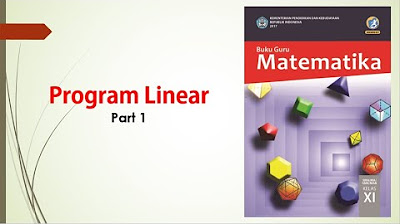1 Linear Programming - Concept17072020
Summary
TLDRThis video lecture introduces students to deterministic optimization and linear programming. It covers the basics of optimization, emphasizing how to formulate and solve linear programming problems to maximize or minimize outcomes. The lecture uses a case study about producing two types of soda drinks, explaining how to set up decision variables, objective functions, and constraints. The focus is on applying linear programming tools to solve practical business problems, such as maximizing profits within given resource limitations, and understanding the underlying theory and methods used in optimization.
Takeaways
- 😀 Linear programming is a key tool in optimization, with applications in various fields like engineering and management.
- 😀 Optimization involves finding the best solution to a problem within given constraints, aiming for the best possible decision or design.
- 😀 Deterministic problems have known variables and parameters, ensuring no uncertainty in their model or system.
- 😀 The focus of this course is on deterministic models, including linear and nonlinear programming, and related approaches like integer programming.
- 😀 Optimization techniques are used to solve a variety of real-world problems, such as capital budgeting, diet problems, and financial modeling.
- 😀 The mathematical formulation of optimization problems involves determining decision variables, objectives (either maximization or minimization), and constraints.
- 😀 In linear programming, the objective is often to maximize profit or minimize costs based on given production processes and constraints.
- 😀 A practical example of linear programming is the 'Gepetto Inc.' case, which involves maximizing profit from producing two products (soda and free) under specific production constraints.
- 😀 The steps in formulating a linear programming problem include defining decision variables, setting objective functions, and specifying constraints for the production process.
- 😀 The course demonstrates solving optimization problems using software tools to handle mathematical formulations and find optimal solutions.
Q & A
What is the focus of the lecture in the transcript?
-The lecture focuses on deterministic optimization, specifically the application of linear programming in solving optimization problems.
What is optimization in the context of the lecture?
-Optimization is the process of selecting the best decision or solution from a set of alternatives, given specific constraints or limitations.
What types of optimization models are discussed in the lecture?
-The lecture discusses deterministic optimization models, including linear programming, nonlinear programming, and other related approaches.
What are the key components of linear programming discussed in the lecture?
-The key components of linear programming include decision variables, the objective function, constraints, and the non-negativity condition.
What is the difference between deterministic and stochastic models in optimization?
-Deterministic models assume that all variables and parameters are known with certainty, while stochastic models account for uncertainty and randomness in the variables.
How is the concept of a 'decision variable' explained in the lecture?
-A decision variable is a value that is determined in the optimization process to achieve the desired outcome or objective, such as the number of products to produce.
What is the objective function in the context of linear programming?
-The objective function is a mathematical expression that represents the goal of the optimization, such as maximizing profit or minimizing cost, subject to the given constraints.
Can you explain the constraints in linear programming with an example?
-Constraints in linear programming are limitations that restrict the feasible solutions. For example, in the case of production, constraints could include time limits, resource availability, or maximum production capacity.
What does the non-negativity condition imply in a linear programming model?
-The non-negativity condition implies that the decision variables must have values greater than or equal to zero, as negative values would not make sense in most practical optimization problems (e.g., negative quantities of products).
What is the example problem discussed in the lecture, and what is the goal of the problem?
-The example problem involves a company producing two types of soda, Soda A and Soda B. The goal is to maximize the weekly profit by determining the optimal number of each soda to produce, given production constraints and costs.
Outlines

This section is available to paid users only. Please upgrade to access this part.
Upgrade NowMindmap

This section is available to paid users only. Please upgrade to access this part.
Upgrade NowKeywords

This section is available to paid users only. Please upgrade to access this part.
Upgrade NowHighlights

This section is available to paid users only. Please upgrade to access this part.
Upgrade NowTranscripts

This section is available to paid users only. Please upgrade to access this part.
Upgrade NowBrowse More Related Video

Machine Learning Classification Using Linear Programming?

The Art of Linear Programming

Program Linear (Part 1) Pertidaksamaan Linear Dua Variabel

ART TEACHES MATHEMATICS IN THE MODERN WORLD-LESSON 1: INTRO TO LINEAR PROGRAMMING

4. Pengenalan FSA Finite State Automata

Matematika Keuangan dan Bisnis - Ep.03 Pengenalan Fungsi
5.0 / 5 (0 votes)